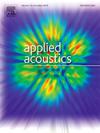基于数据的船舶真实声学特征螺旋桨尖涡空化噪声建模
IF 3.4
2区 物理与天体物理
Q1 ACOUSTICS
引用次数: 0
摘要
螺旋桨尖涡空化(TVC)噪声对航行船舶的声学特征有显著影响。然而,由于TVC噪声的复杂性,目前还没有对其进行详细的仿真研究。为了提高被动声纳模拟器的真实感,提出了一种先进的基于数据的螺旋桨TVC噪声生成方法。采用生成式对抗网络随机生成TVC噪声源的波形,采用TVC出现的概率表示,根据航速连续生成TVC噪声源波形。利用统计度量和听觉特征的性能指标对所提出的方法进行了验证。该方法模拟的信号有效地反映了螺旋桨TVC噪声随航速变化的时频特性。本文章由计算机程序翻译,如有差异,请以英文原文为准。

Data-based modeling of propeller tip-vortex cavitation noise for realistic acoustic ship signature
Propeller tip-vortex cavitation (TVC) noise significantly influences the acoustic signature of a navigating vessel; however, its detailed simulation has not been extensively developed thus far, owing to the complexity of TVC noise. This paper proposes an advanced data-based method for generating propeller TVC noise to enhance the realism of passive sonar simulators. Generative adversarial networks are applied to randomly create waveforms of TVC noise sources, and a probabilistic representation of TVC occurrences is adopted to continuously generate them depending on the ship speed. The proposed method is validated using the performance metrics of statistical measures and auditory features. The signals simulated by the proposed method effectively represent the time–frequency characteristics of the propeller TVC noise depending on the ship speed.
求助全文
通过发布文献求助,成功后即可免费获取论文全文。
去求助
来源期刊

Applied Acoustics
物理-声学
CiteScore
7.40
自引率
11.80%
发文量
618
审稿时长
7.5 months
期刊介绍:
Since its launch in 1968, Applied Acoustics has been publishing high quality research papers providing state-of-the-art coverage of research findings for engineers and scientists involved in applications of acoustics in the widest sense.
Applied Acoustics looks not only at recent developments in the understanding of acoustics but also at ways of exploiting that understanding. The Journal aims to encourage the exchange of practical experience through publication and in so doing creates a fund of technological information that can be used for solving related problems. The presentation of information in graphical or tabular form is especially encouraged. If a report of a mathematical development is a necessary part of a paper it is important to ensure that it is there only as an integral part of a practical solution to a problem and is supported by data. Applied Acoustics encourages the exchange of practical experience in the following ways: • Complete Papers • Short Technical Notes • Review Articles; and thereby provides a wealth of technological information that can be used to solve related problems.
Manuscripts that address all fields of applications of acoustics ranging from medicine and NDT to the environment and buildings are welcome.
 求助内容:
求助内容: 应助结果提醒方式:
应助结果提醒方式:


